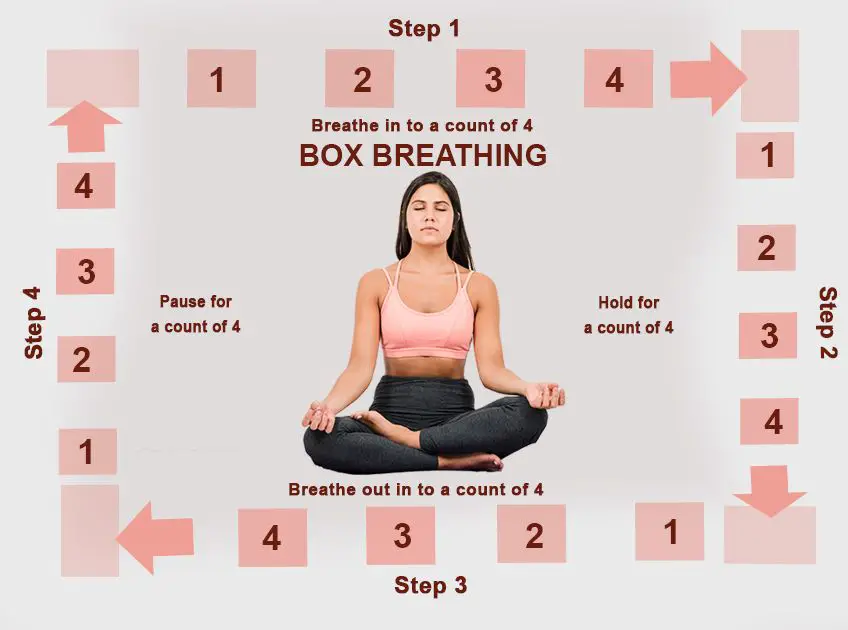
Important: This article is for informational purposes only. Please read our full disclaimer for more details.
In our fast-paced world, managing stress is essential for our well-being. One technique gaining prominence is box breathing, a powerful method to restore calmness after stress. In this article, we’ll explore box breathing’s essence, steps, and benefits, suitable for high-stress professions and anyone seeking tranquility.
What is Box Breathing?
Also known as four-square breathing, it’s rooted in controlled breath, promoting relaxation and mental clarity through a rhythmic cycle: inhale, hold, exhale, pause, each for a count of four.
Why is Box Breathing Beneficial?
- Regulates the body’s stress response
- Reduces production of stress hormones like adrenaline
- Clears the mind and relaxes the body
- Enhances focus and concentration
Who Can Benefit from Box Breathing?
- Soldiers, police officers, and emergency responders in high-stress professions
- Busy professionals facing hectic workdays
- Individuals dealing with everyday stressors
- Universally accessible, beneficial for anyone regardless of occupation
How to do box breathing

To do box breathing, follow these steps:
- Sit in a comfortable position with your back straight and your feet flat on the floor.
- Close your eyes and place one hand on your chest and the other on your stomach.
- Breathe in slowly and deeply through your nose for four counts.
- Hold your breath for four counts.
- Breathe out slowly and completely through your mouth for four counts.
- Hold your breath for four counts.
- Repeat steps 3-6 for several minutes.
Benefits of Box Breathing
Box breathing is a simple but effective breathing exercise that can be used to reduce stress, improve focus, and boost mood. It has been shown to have a number of benefits[1], including:
- Stress Reduction [2]: Box breathing calms the nervous system, reducing stress and anxiety levels effectively.
Improved Focus: Regular practice enhances concentration and mental clarity, aiding productivity and decision-making. - Emotional Balance: By promoting relaxation, box breathing helps manage emotions, fostering a more balanced outlook.
- Better Sleep: Incorporating box breathing into bedtime routines can improve sleep quality, aiding in falling asleep faster and experiencing deeper rest.
- Enhanced Resilience: Regular use builds emotional resilience, enabling individuals to cope better with challenging situations.
- Lower Blood Pressure: Controlled breathing techniques like box breathing have been linked to reduced blood pressure, benefiting heart health.
- Pain Management: Box breathing can assist in pain management by promoting relaxation and reducing the perception of pain.
- Increased Self-Awareness: Through mindful breathing, individuals gain better self-awareness, connecting with their thoughts and emotions more profoundly.
- Boosted Immune Function: Stress reduction via box breathing may contribute to enhanced immune system function, supporting overall health.
- Encourages Mindfulness: Practicing box breathing encourages mindfulness, fostering a present-moment focus and awareness.
Box breathing is a great way to improve your overall well-being. It is easy to learn and can be done anywhere, at any time.
| Kelly McGonigal, PhD: “Box breathing is a simple but powerful way to calm your nervous system and reduce stress.” |
Tips for Beginners
- Start Slow: Gradually increase practice time.
- Comfortable Environment: Minimize distractions.
- Consistent Practice: Make it a daily habit.
- Proper Posture: Maintain an upright yet relaxed position.
- Counting Aid: Use a timer for precise counts.
- Be Patient: Mind may wander initially.
- Modify as Needed: Adapt to your comfort level.
- Stay Hydrated: Hydration enhances effectiveness.
- Combine with Visualization: Enhance relaxation.
- Seek Guidance: Use guided meditation apps for assistance.
| “Box breathing is my go-to for calming down before a big presentation or when I’m feeling overwhelmed.” – Arianna Huffington |
How Often to Do Box Breathing
- Daily Practice: Incorporate it daily for tranquility.
- Stress Management: Use during stressful moments.
- Intermittent Breaks: Maintain emotional balance.
- Pre-Event Ritual: Reduce anxiety before significant events.
- Self-Awareness: Adjust based on comfort.
When to Do Box Breathing
- Morning Ritual: Start the day with calmness.
- Stressful Situations: Restore composure in high stress.
- Before Sleep: Promote restful sleep.
- Workday Breaks: Revitalize focus.
- Pre-Event Preparation: Reduce anxiety.
- Mindful Pause: Regain control during overwhelm.
Tips for Maximizing Box Breathing
- Practice in a quiet, comfortable space.
- Focus on breath and body sensations.
- Be patient; results may not be immediate.
| “I started practicing box breathing a few months ago and I’ve noticed a big difference in my stress levels. I used to get really anxious before speaking in public, but now I can use box breathing to calm myself down and deliver my presentation with confidence.” – @SarahSmith |
Box Breathing Safety Tips
- Consult a doctor if you have underlying medical conditions.
- Halt if you feel lightheaded, dizzy, or nauseous.
- Avoid practicing while driving or operating machinery.
- Pregnant individuals should consult a healthcare provider.
In the modern chaos, moments of peace are like hidden treasures. Box breathing, rooted in rhythmic inhalation and exhalation, brings serenity. This practice can transform how we cope with stress, promoting well-being in chaotic lives. Embrace box breathing and invite tranquility through the gentle rhythm of your breath.
Related Articles















